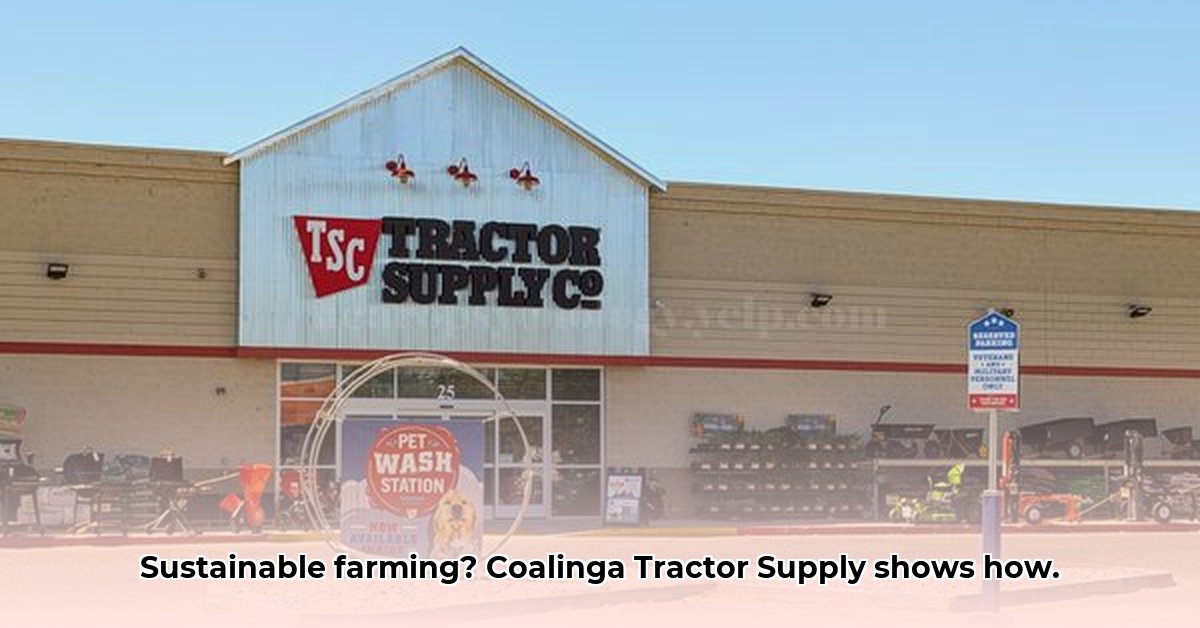
Coalinga Tractor Supply (TSC) plays a pivotal role in the agricultural heartland of Coalinga, California. This case study analyzes its contribution to the community's agricultural success, focusing on its role in promoting sustainable practices. We examine its product offerings, customer base, and operational challenges, highlighting significant data gaps and proposing actionable steps for improvement. For information on American-made tractors, check out this resource: American Tractor Info.
Coalinga's Agricultural Landscape
Coalinga's economy is deeply intertwined with agriculture. The fertile land supports a diverse range of crops, making agricultural retail a vital sector. Tractor Supply Coalinga serves as a critical link, providing farmers and ranchers with essential tools and supplies. Understanding its operations provides insight into the broader agricultural ecosystem's health and sustainability.
Analyzing Coalinga Tractor Supply
TSC Coalinga functions as a one-stop shop, offering a wide range of products, from tractor parts and animal feed to hardware and gardening supplies. Its staff fosters strong customer relationships, providing valuable advice and personalized service. This personalized approach builds loyalty within the close-knit community. However, a significant limitation is the absence of quantifiable data regarding sales figures, customer demographics, and, critically, the store's sustainability practices. This lack of information prevents a comprehensive evaluation of its overall impact. How can we accurately assess its contributions without concrete data on product sourcing, waste management, or energy consumption?
The Sustainability Data Gap: A Critical Limitation
The absence of detailed data on TSC Coalinga’s sustainability practices represents a significant impediment to a thorough analysis. Understanding its environmental impact requires quantifiable information on several key areas: product sourcing (what percentage is locally sourced and environmentally friendly?), waste management practices, and energy efficiency measures. Without this data, we can only speculate about the store’s contribution to sustainable agriculture. This lack of transparency hinders any meaningful assessment of its environmental performance and the development of effective strategies for improvement.
Actionable Intelligence for Stakeholders
To address these shortcomings, a collaborative effort is needed:
TSC Coalinga Management: Conduct customer surveys to understand needs and preferences; meticulously analyze sales data to pinpoint high-demand items and identify opportunities for incorporating sustainable product lines. Implement robust tracking systems to gather concrete data on energy consumption, waste generation, and product sourcing. (Long-term: Develop a comprehensive sustainability report, including detailed information on sustainability practices and supply chain management. Consider investing in an e-commerce platform to expand reach and enhance customer convenience.)
Local Farmers/Producers: Participate in customer surveys to provide feedback on unmet needs; actively collaborate with TSC Coalinga to develop regionally adapted, sustainable product lines that align with their specific requirements and sustainability goals. (Long-term: Invest in employee training programs to promote best practices in sustainable agriculture.)
Consumers: Participate in customer surveys and communicate feedback directly with TSC staff regarding product availability, quality, and sustainability concerns. (Long-term: Advocate for environmentally responsible practices within the community and support businesses committed to sustainable practices).
Recommendations for Enhancing Sustainability at TSC Coalinga
To ensure TSC Coalinga's continued contribution to the community while enhancing its commitment to sustainable practices, focused action is required:
Enhanced Data Collection and Transparency: Implement systems to track and publicly report key environmental metrics, enhancing transparency and fostering community trust.
Prioritize Sustainable Product Sourcing: Actively promote environmentally friendly products and work directly with suppliers committed to sustainable manufacturing processes.
Energy Efficiency Improvements: Invest in energy audits and implement energy-saving measures, potentially exploring renewable energy sources.
Comprehensive Waste Reduction Strategies: Implement detailed waste reduction and recycling programs, including safe disposal of hazardous materials.
Community Engagement and Education: Partner with local farmers and community organizations to educate consumers about sustainable agriculture, offering workshops and informative programs.
Conclusion
TSC Coalinga is crucial to Coalinga’s agricultural economy. However, a lack of readily available sustainability data prevents a complete assessment of its impact. By implementing the recommended actions, TSC Coalinga can significantly enhance its contribution to sustainable agriculture, benefiting both the community and the environment. Further research, including robust data collection and comparative analysis, is essential to fully understand TSC Coalinga’s role within this dynamic agricultural landscape.